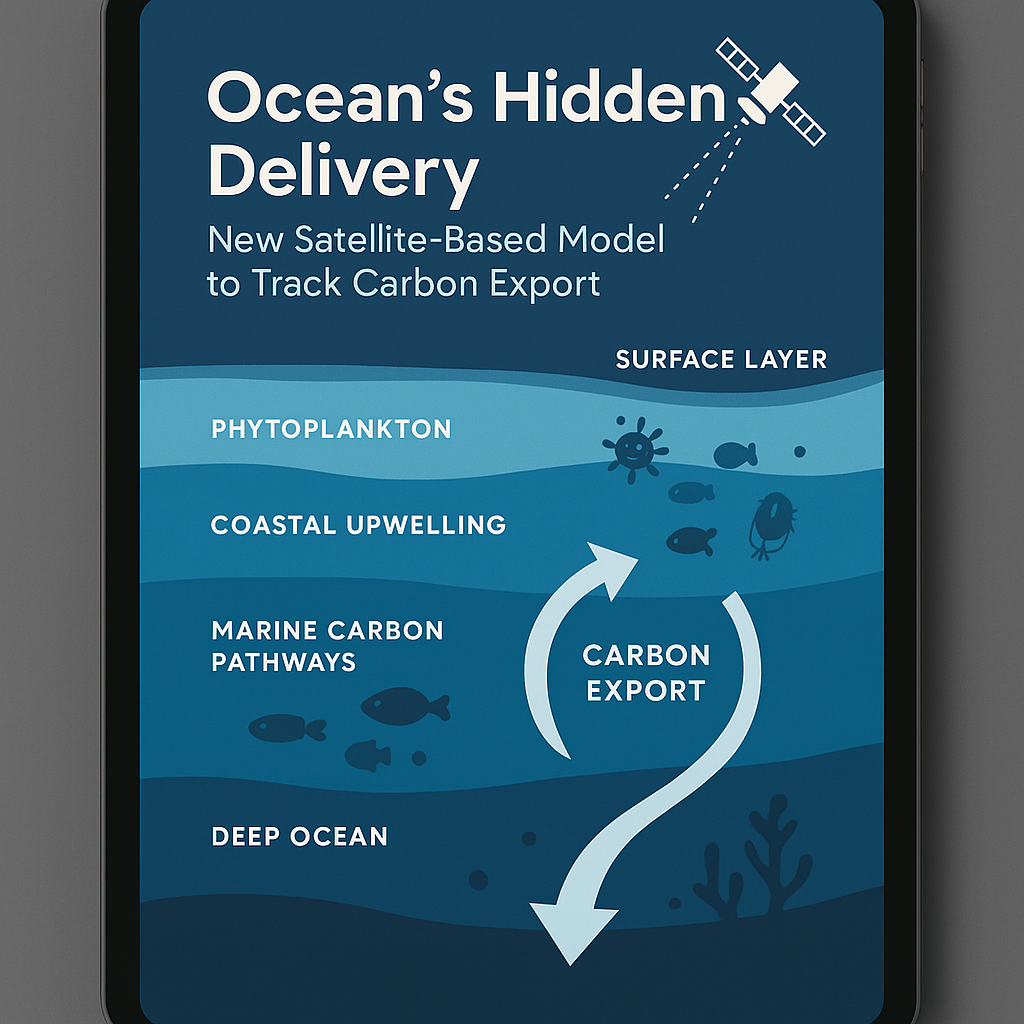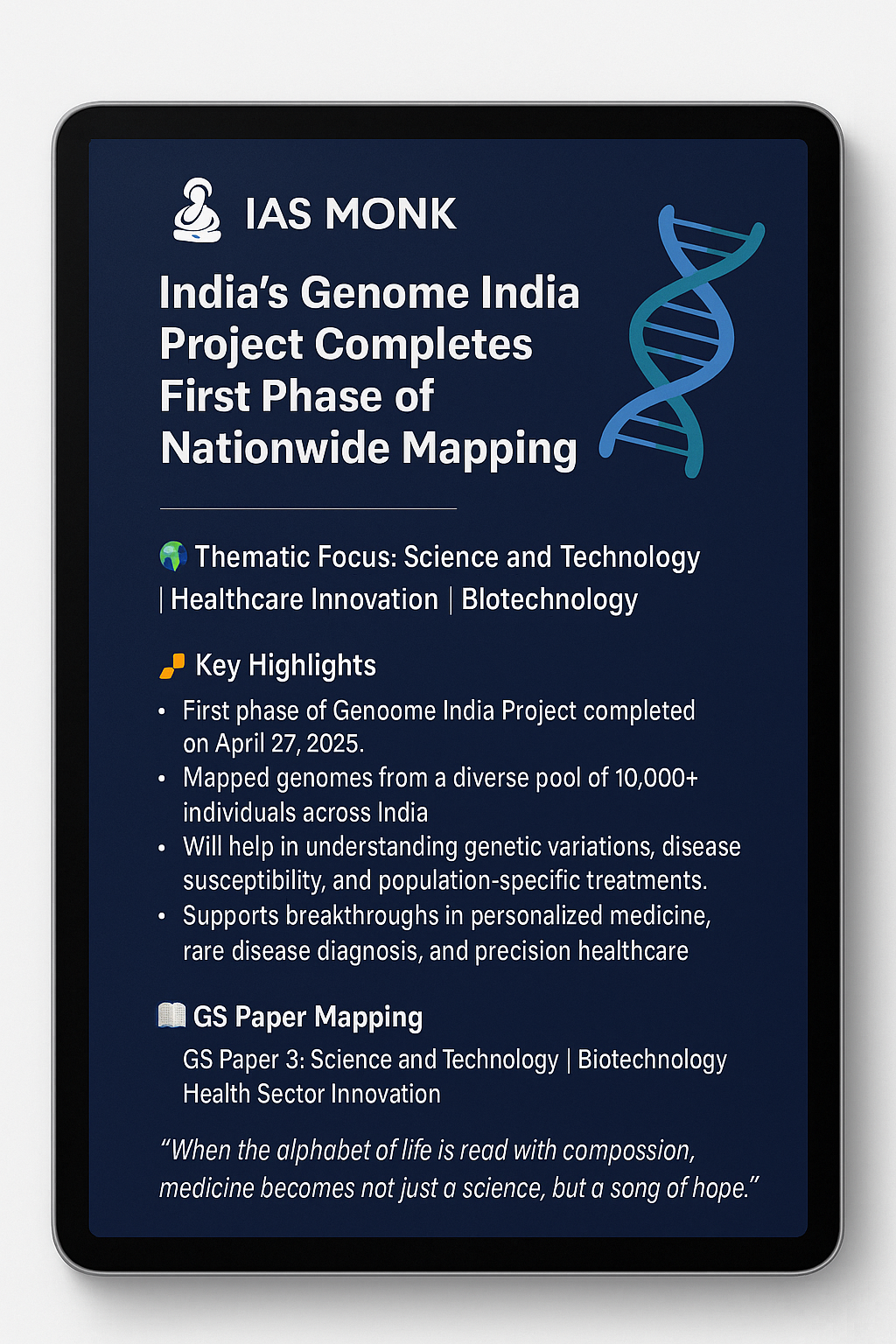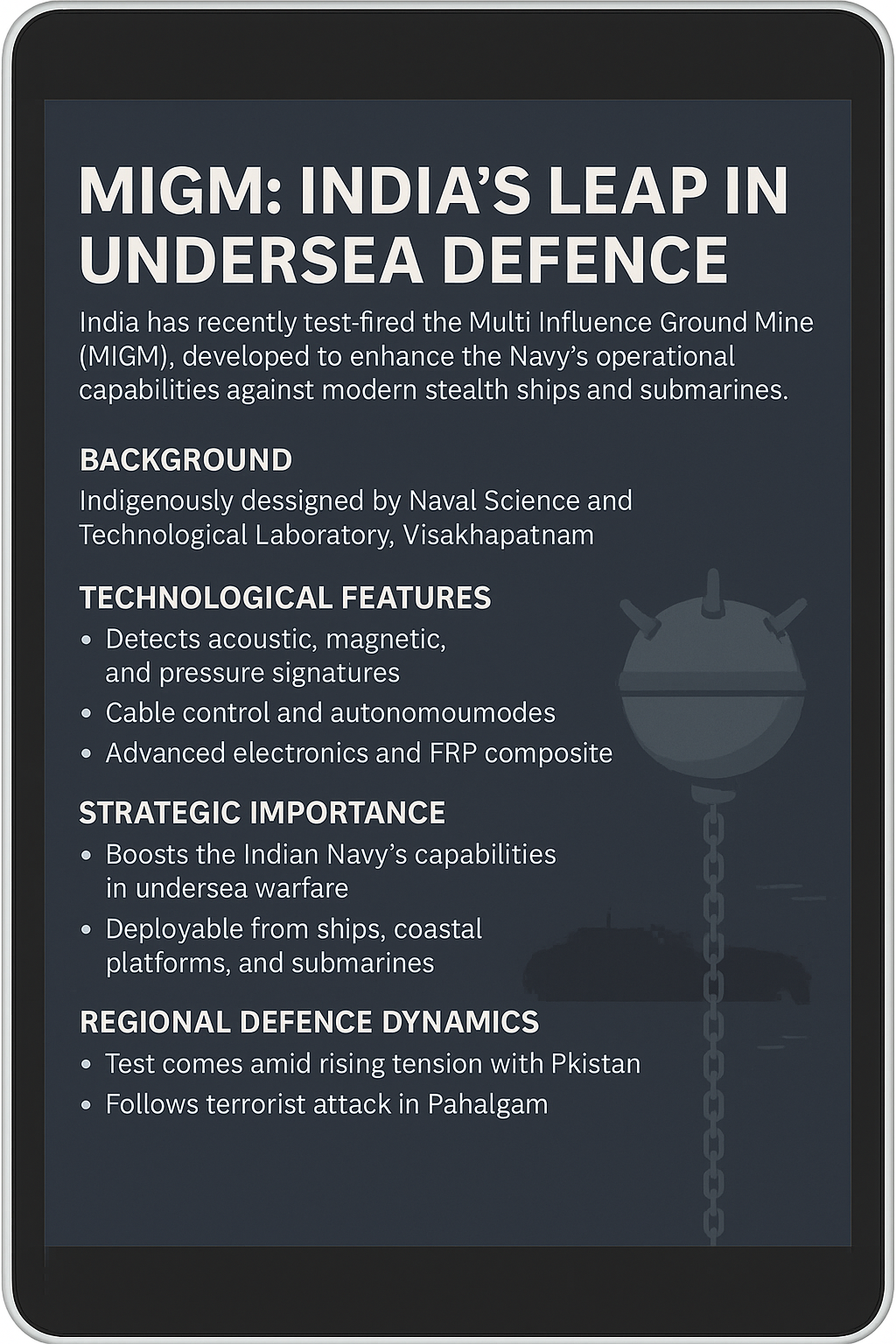
📅 May 9, 2025, Post 9: Ocean’s Hidden Delivery: New Satellite-Based Model to Track Carbon Export | Mains Essay / Target IAS-26 MCQs Attached: A complete Package, Dear Aspirants!
Ocean’s Hidden Delivery: New Satellite-Based Model to Track Carbon Export

NEWS DROP — PETAL 009
🗓️ Date: May 9, 2025
🌊 Thematic Focus: GS3 – Environment | Oceanography | Climate Change
🌿 Intro Whisper:
Beneath the waves, a silent courier moves carbon to the depths—shaping the rhythm of Earth’s climate.
🌊 What is Carbon Export?
- Carbon export refers to the transfer of atmospheric carbon dioxide into the deep ocean, where it can be stored for long periods.
- It plays a key role in the global carbon cycle and climate regulation.
- The biological pathway involves phytoplankton, which absorb CO₂ and convert it into organic carbon that can sink.
🌿 The Role of Phytoplankton
- Phytoplankton are microscopic organisms that photosynthesise at the sunlit ocean surface.
- They form the base of the marine food web and initiate carbon sequestration.
- As they die or are consumed, carbon-rich waste and biomass sink, forming part of the biological pump.
🌀 Coastal Upwelling & Marine Carbon Pathways
- Upwelling regions, such as the California Current, bring nutrient-rich water to the surface.
- This supports high phytoplankton productivity and feeds a cascade of carbon transfer through marine life.
- Ultimately, organic carbon reaches deeper layers, aiding long-term sequestration.
📡 New Satellite-Based Modelling Approach
- Developed by MBARI and Florida State University, this model improves carbon export prediction.
- It integrates satellite data (wind, current, ocean colour) with a new Lagrangian growth-advection model.
- This model tracks plankton movement and succession through ocean currents, capturing time-lagged effects in carbon flow.
🧠 Key Innovations in the Model
- Moves beyond surface-only assessments from ocean colour data
- Accounts for zooplankton impacts, spatial lags, and food web dynamics
- Predicts export even in cases where satellite chlorophyll signals are low or delayed
🔬 Future Research Directions
- Explore deep-sea carbon pulses observed at long-term sites
- Use machine learning to refine catchment zones and planktonic biodiversity analysis
- Expand model to global ocean regions for climate forecasting and policymaking
🛰️ Significance of Satellite Integration
- Combines satellite observations with in situ data
- Enhances understanding of invisible carbon flows beneath the ocean surface
- Supports efforts in carbon budgeting, climate change mitigation, and ecosystem modeling
📘 GS Paper Mapping:
- GS Paper 3: Environmental Conservation | Carbon Sequestration | Ocean-Based Climate Solutions
- Essay: “Oceans as Climate Engineers: Tracking the Sinking Path of Carbon”
🌠 Closing Thought:
In the deep blue archives of the sea, the planet stores its breath. To understand carbon, we must listen not just to the air—but to the silence beneath the surface.
Target IAS-26: Daily MCQs :
📌 Prelims Practice MCQs
Topic:
MCQ 1: Type-1 — “How many of the above statements are correct?”
Consider the following statements regarding carbon export and oceanographic research:
1. Carbon export refers to the long-term storage of carbon in ocean sediments after phytoplankton absorb CO₂.
2. The Lagrangian model developed by MBARI tracks phytoplankton using real-time wind and cloud satellite imagery.
3. Coastal upwelling regions increase phytoplankton productivity, enhancing the biological pump.
4. Phytoplankton die or are consumed, and their organic carbon may sink to deeper ocean layers.
How many of the above statements are correct?
A) Only two
B) Only three
C) All four
D) Only one
🌀 Didn’t get it? Click here (▸) for the Correct Answer & Explanation
✅ Correct Answer: B) Only three
🧠 Explanation:
1) Correct – Phytoplankton absorb CO₂, and sinking biomass helps store carbon in deeper waters.
2) Incorrect – The Lagrangian model uses ocean current data, not real-time cloud imagery.
3) Correct – Upwelling brings nutrients that fuel phytoplankton blooms.
4) Correct – These dead cells or waste particles contribute to deep carbon export.
MCQ 2: Type-2 — Two-Statement Assertion
Consider the following statements:
Ocean colour satellite data accurately captures both surface and subsurface phytoplankton activity.
Zooplankton movement and food web dynamics influence how much carbon is exported to the deep sea.
A) Only 1 is correct
B) Only 2 is correct
C) Both are correct
D) Neither is correct
🌀 Didn’t get it? Click here (▸) for the Correct Answer & Explanation
✅ Correct Answer: B) Only 2 is correct
🧠 Explanation:
1) Incorrect – Ocean colour data fails to detect subsurface dynamics, leading to gaps in carbon modeling.
2) Correct – Zooplankton play a crucial role in regulating the carbon flux through consumption and movement.
MCQ 3: Type-3 — “Which of the above statements is/are correct?”
Consider the following statements about recent ocean carbon research:
1. The new model successfully predicts carbon export without relying solely on satellite colour data.
2. MBARI’s model incorporates both biological growth and ocean current advection.
3. Machine learning is being used to improve predictions of surface carbon catchment areas.
4. Phytoplankton perform chemosynthesis to capture carbon in ocean depths.
Which of the above statements is/are correct?
A) 1, 2 and 3 only
B) 1, 3 and 4 only
C) 2, 3 and 4 only
D) All four
🌀 Didn’t get it? Click here (▸) for the Correct Answer & Explanation
✅ Correct Answer: A) 1, 2 and 3 only
🧠 Explanation:
1) Correct – The new model moves beyond surface-only ocean colour reliance.
2) Correct – It is a Lagrangian growth-advection model tracking organism flow through currents.
3) Correct – Machine learning is being explored to refine spatial predictions.
4) Incorrect – Phytoplankton perform photosynthesis, not chemosynthesis.
MCQ 4: Type-4 — Direct Factual Question
Which of the following institutions developed the new satellite-integrated model to estimate ocean carbon export?
A) National Institute of Oceanography, India
B) NASA and NOAA
C) MBARI and Florida State University
D) UNEP and IPCC
🌀 Didn’t get it? Click here (▸) for the Correct Answer & Explanation.
✅ Correct Answer: C) MBARI and Florida State University
🧠 Explanation:
C) The model was developed by the Monterey Bay Aquarium Research Institute (MBARI) and Florida State University to improve ocean carbon export prediction.


















